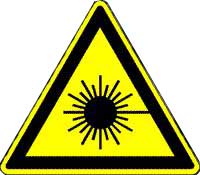Laser safety
All lasers and laser light show systems have intrinsic dangers - even laser pointers! Observation of basic laser safety rules and the specific safety regulations of the jurisdiction in which you operate are essential.
Safety with high powered lasers is a critical issue that cannot be overlooked. Despite their brilliant beams and ability to burn, high power laser pointers and portable lasers are only a danger to your eyes. The danger that lasers represent to your eyes though is very serious. The visual receptors in your eyes are part of your central nervous system which means if your eyes are damaged, they do not heal or recover.
As far as power output, laser pointers and portable lasers do not release that much power. Especially not when compared to a normal 75W or 100W light globe. What makes the light from lasers so dangerous is that it has two unique properties.
Coherent and focused. The energy is focused on a very small area similar to the way a magnifying glass focuses the sun.
Collimated. The light does not spread out from a laser, it stays in a focused narrow beam that makes lasers almost as dangerous at a distance as close up.
This not to say you should be afraid of lasers or avoid using them. What you should do how ever is to treat lasers with respect, be aware of their dangers and follow some basic guidelines to ensure your safety.
Guidelines
Never point your laser at another person, especially their face.
Never under any circumstances look directly into the laser beam. Even if it is a low powered laser, you don't want to take chances with your eyes.
Always be conscious of and aware of reflective surfaces such as mirrors, polished metal or glass. A reflected beam can also harm your eyes.
Only use laser in a controlled environment.
Do not let other people use your laser unless they are fully aware of the dangers of lasers.
Laser beams can go for miles so never randomly use your laser outside.
Wear laser safety glasses if you are using your high power laser for dangerous applications. If you adhere to these guidelines and exercise simple common sense and care, you will be able enjoy and use your high power lasers in complete safety.
Classification Criteria
The government recommended safety practices for a given laser system will depend on its classification. The following list highlights the criteria used to classify lasers, as well as listing the key safety considerations when operating a system within the indicated classification. See "Code of Federal Regulations" for a comprehensive discussion of these safety topics.
Wavelength:
If the laser is designed to emit multiple wavelengths the classification is based on the most hazardous wavelength.
Output Characteristics:
For continuous-wave (CW) or repetitively pulsed lasers the average output power (watts) and limiting exposure time inherent in the design are considered.
For pulsed lasers the total energy per pulse (joule), pulse duration, pulse repetition frequency and emergent beam radiant exposure are considered.
Laser Classification
Class I Lasers
These systems are also classified as "Exempt" lasers. They are normally not hazardous with respect to continuous viewing, or are designed in a way that prevents human access to laser radiation (e.g., laser printers).
Class II Lasers (Low Risk)
These lasers emit visible light, which, due to normal human reflex responses, do not present a hazard. However, a safety risk would be posed if the output source were brought to within close proximity of the eye and then viewed for an extended period of time.
Class III Lasers (Moderate Risk)
Class III lasers can cause eye injury if viewed momentarily, but are not capable of causing serious skin injury or hazardous diffuse reflections without the use of collecting/conditioning optics (e.g., fiber optics, telescopes, etc.).
Class IV Lasers (High Risk)
These lasers present an eye hazard from direct and diffuse reflections. In addition, class IV lasers can cause combustion of flammable materials and produce serious skin burns and injury from direct exposure. Most laser systems manufactured by Coherent fall into this classification.
